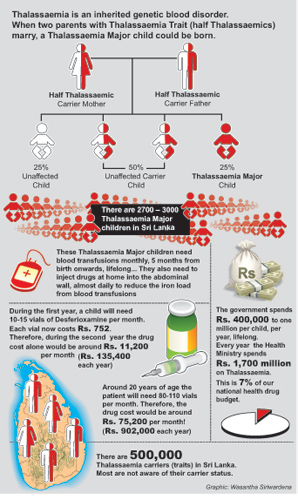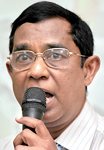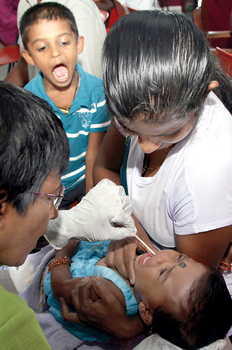Parents, you’re not alone
It is poya and as white-clad devotees walk sedately up Athugala in Kurunegala to offer flowers at the Samadhi Buddha statue, down below teams of doctors from several hospitals are engaged in a different kind of meritorious deed.
In the crowded hall of the Red Cross building in the heart of Kurunegala town, a strange scene is being enacted on September 19 and October 18 – strange it may be, but it is giving a glimmer of hope to families whose despair is like an abyss from which there is no return.

The doctors from the hospitals in Kandy, Kurunegala and Kegalle and Peradeniya’s Sirimavo Bandaranaike Children’s Hospital and the Dental Faculty, seated at 10 tables, are taking swabs from the cheek cavities of children and their siblings.
We need four cheek swabs from each child and the sibling if the child has one, explains Consultant Obstetrician and Gynaecologist, Dr. Kalinga Nanayakkara, while several ‘organisers’ attempt to bring about some order among the men, women and children who have come from far and wide.
Those crowding round the doctors in their enthusiasm are the families with a child with Thalassaemia major and they have come from Kurunegala, Anuradhapura, Polonnaruwa, Kandy, Badulla and Ragama.
Just outside the hall, little Thisani Saksana from Nikeweratiya, poses like a model with her head tilted to a side and a beautiful smile, while munching a biscuit. “This is our second child,” says her father who does not wish to be identified because of the stinging stigma attached to Thalassaemia. With heart-rending frankness he tells us that everything, “geval dorawal”, have been sold in a desperate bid to save his little girl.

Dr. Kalinga Nanayakkara
Coming from two villages, 30 kilometres apart, he is puzzled as he points out that he and his wife are not related. Piyadasage Priyantha Bandara, 28, working in Tantirimale as a civil arakshaka and wife Kalyani from Kahatagasdigiliya are also bemused. Jeevithaya kada wetuna, api wahakai, says Priyantha, adding that both of them are carriers and when they found out that their son, Hiranye Udith, born a year ago is a victim, their world collapsed.
The father’s eyes take on a sad, haunted look as he says that they thought only a bond between relatives would produce such children.

Cheek swab time at Kurunegala. Pix by M.A. Pushpa Kumara
Only parents with children stricken by Thalassaemia understand the agony of others in a similar situation, he laments, describing how every single month their son has to be given a blood transfusion.
More and more tales pour forth. For N.S. Susantha Kumara Karunaratne, 31, from Anuradhapura who is in the army and Nadeeka Dilrukshi from Pusselgolla in Badulla the happiest moment of their marriage came when Umesa Akalpa was born in 2008.
A few months after his first birthday, came the first signs that everything was not right with their baby – he was becoming thin.
“He just wouldn’t eat anything and got bouts of fever,” says Nadeeka, with the hospital visits beginning then. Holding their baby close, they watched in shock as other children with swollen tummies died at the hospital.
Kohomahari bereganna one, says Susantha with determination, adding that they need to save their child somehow.
These parents were among the 200 who had brought their children for cheek swabs to be taken. The first set of cheek swabs have already been sent to a genetic laboratory in New York, United States of America and the second set is in the process of being sent.
This is the result of an effort that began when Dr. Nanayakkara, was working at the Kurunegala Teaching Hospital and saw parents and children coming to the National Thalassaemia Centre there. Dr. Nanayakkara would witness their agony and chat to them.
Many parents had accepted their “karume” with stoic resignation and were fighting a lonely battle against this disease which required that they had to bring their children for a blood transfusion every single month until…….the ultimate was unspeakable but also a reality facing them. For, most children suffering from Thalassaemia major would not survive beyond 30 years of age.
With 500,000 Thalassaemia carriers (traits) in Sri Lanka and most being unaware of their carrier status, there are around 2,700-3,000 Thalassaemia major children in the country, points out Dr. Nanayakkara, explaining that Thalassaemia is an inherited genetic blood disorder. When a couple with Thalassaemia Trait (half thalassaemics) marry, a Thalassaemia major child could be born.
Wondering how he could be of help to these children and parents, the idea of forming a group dawned on him when in October 2012 (last year), Dr. Nanayakkara met a world pioneer in bone marrow transplantations at a meeting in Rome, Italy. It was the Director of the Mediterranean Institute of Haematology, Rome, Prof. Guido Lucarelli who has performed this procedure for 20 years.
It was then that Dr. Nanayakkara became the catalyst in the formation of the ‘Lanka Thalassaemia Circle’ to encompass not only Thalassaemia patients and their parents but also well-wishers to fight for the neglected rights and treatment of these children.
Started with just three members, the news had spread like wildfire and now the Thalassaemia Circle has 2,700.
To be registered as a non-governmental organisation to detect and eradicate Thalassaemia, it has been affiliated to the Thalassaemia International Federation (TIF) in Cyprus with a membership of more than 3,000.
Explaining why cheek swabs were taken on September 19 and October 18, Dr. Nanayakkara says that to carry out bone marrow transplantation for Thalassaemia, the affected child (who would be the recipient of the bone marrow) and the donor should have a 6/6 Human Leukocyte Antigen (HLA) genetic match.
Regrettably, HLA typing is still not available in Sri Lanka and the Lanka Thalassaemia Circle had arranged to send the first set of 100 cheek swabs from affected children and their siblings to the a genetic laboratory in New York in concurrence with the President of the ‘Bone Marrow Donor Programme’ in Singapore.
In the September batch, the results have already been received and the reports forwarded to Rome to read them to ascertain the ‘low resign’ matches among the 100. Once that is received, the ‘low resolution’ matching samples will be checked for ‘high resolution’ matches back again in New York. These are the children who should go in for bone marrow transplantation and a cure, adds Dr. Nanayakkara.
Box: Bone Marrow Transplantation Centre a must With stem-cell therapy being used for the cure of Thalassaemia in many countries and the stem cells being obtained from bone marrow, the establishment of Bone Marrow Transplantation Centres with the support of the Health Ministry is the primary goal of the Lanka Thalassaemia Circle, reiterates Dr. Nanayakkara.
Stem cells can also be used to cure many other diseases including leukaemias , myelomas and other cancers, points out Dr. Nanayakkara, working out the math by suggesting that the high cost of treatment of children stricken with Thalassaemia could be avoided if they can be cured through bone marrow transplantation.
The initiative to set up Bone Marrow Transplantation Centres had a boost when the Medical Director of the international non-profit NGO, Cure2Children Foundation, Dr. Lawrence Faulkner, who has established such centres in Jaipur, India and Islamabad, Pakistan, paid a visit to Kurunegala to meet the Lanka Thalassaemia Circle, it is learnt.
Bone Marrow Transplantation Centres a must
With stem-cell therapy being used for the cure of Thalassaemia in many countries and the stem cells being obtained from bone marrow, the establishment of Bone Marrow Transplantation Centres with the support of the Health Ministry is the primary goal of the Lanka Thalassaemia Circle, reiterates Dr. Nanayakkara.
Stem cells can also be used to cure many other diseases including leukaemias , myelomas and other cancers, points out Dr. Nanayakkara, working out the math by suggesting that the high cost of treatment of children stricken with Thalassaemia could be avoided if they can be cured through bone marrow transplantation.
The initiative to set up Bone Marrow Transplantation Centres had a boost when the Medical Director of the international non-profit NGO, Cure2Children Foundation, Dr. Lawrence Faulkner, who has established such centres in Jaipur, India, and Islamabad, Pakistan, paid a visit to Kurunegala to meet the Lanka Thalassaemia Circle, it is learnt.
comments powered by Disqus

